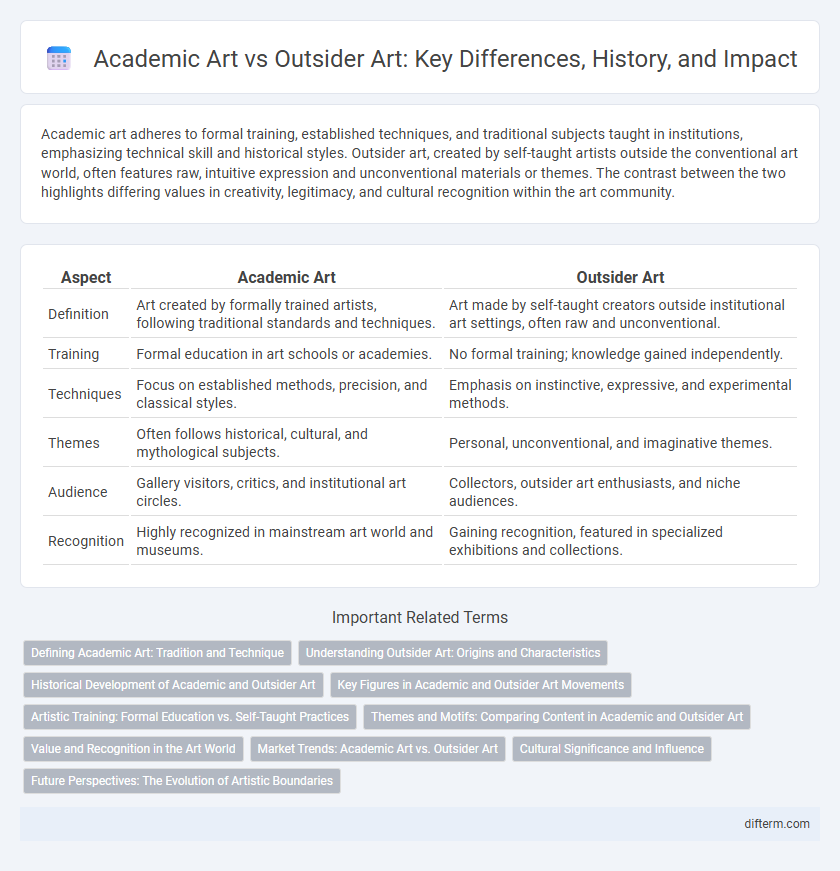Academic art adheres to formal training, established techniques, and traditional subjects taught in institutions, emphasizing technical skill and historical styles. Outsider art, created by self-taught artists outside the conventional art world, often features raw, intuitive expression and unconventional materials or themes. The contrast between the two highlights differing values in creativity, legitimacy, and cultural recognition within the art community.
Table of Comparison
| Aspect | Academic Art | Outsider Art |
|---|---|---|
| Definition | Art created by formally trained artists, following traditional standards and techniques. | Art made by self-taught creators outside institutional art settings, often raw and unconventional. |
| Training | Formal education in art schools or academies. | No formal training; knowledge gained independently. |
| Techniques | Focus on established methods, precision, and classical styles. | Emphasis on instinctive, expressive, and experimental methods. |
| Themes | Often follows historical, cultural, and mythological subjects. | Personal, unconventional, and imaginative themes. |
| Audience | Gallery visitors, critics, and institutional art circles. | Collectors, outsider art enthusiasts, and niche audiences. |
| Recognition | Highly recognized in mainstream art world and museums. | Gaining recognition, featured in specialized exhibitions and collections. |
Defining Academic Art: Tradition and Technique
Academic art emphasizes rigorous training in classical techniques and adherence to established artistic traditions rooted in European academies. It prioritizes mastery of anatomy, perspective, and precise composition, often depicting historical, mythological, or religious themes. This approach contrasts with outsider art, which values raw expression and creativity beyond formal academic constraints.
Understanding Outsider Art: Origins and Characteristics
Outsider art, also known as art brut, originates from self-taught artists working outside traditional academic institutions, often including individuals with no formal training or those marginalized by society. Its characteristics emphasize raw creativity, unfiltered expression, and unconventional techniques, which contrast with the structured methodologies and theoretical foundations prevalent in academic art. Understanding outsider art requires recognizing its intrinsic value, emotional intensity, and unique perspectives that challenge conventional art norms.
Historical Development of Academic and Outsider Art
Academic art emerged during the Renaissance, rooted in formal training at established institutions like the French Academy, emphasizing classical techniques, realism, and historical or mythological subjects. Outsider art, also known as art brut, originated in the 20th century, created by self-taught artists outside the conventional art world, often driven by personal vision and raw expression. The historical development of these contrasting art forms reflects shifting cultural values, with academic art dominating formal exhibitions and outsider art gaining recognition for its authenticity and innovation.
Key Figures in Academic and Outsider Art Movements
Key figures in academic art include Jean-Leon Gerome and William-Adolphe Bouguereau, known for their mastery of classical techniques and adherence to formal art institutions. Outsider art highlights self-taught artists like Henry Darger and Adolf Wolfli, whose works often exhibit raw creativity and unorthodox perspectives outside traditional academia. These contrasting art movements emphasize the divide between institutionalized training and individualistic expression in art history.
Artistic Training: Formal Education vs. Self-Taught Practices
Academic art emphasizes structured curricula, mastery of traditional techniques, and historical art theories acquired through formal education at established institutions. Outsider art thrives on intuitive creativity, with self-taught artists often using unconventional methods uninfluenced by academic standards or mainstream art movements. This contrast highlights how institutional training shapes technical precision, while self-taught practices foster raw expression and originality.
Themes and Motifs: Comparing Content in Academic and Outsider Art
Academic art often explores classical themes such as mythology, history, and human anatomy, emphasizing technical precision and adherence to established aesthetics. Outsider art prioritizes raw, personal narratives and unconventional motifs, reflecting individual experience and emotional expression without formal training. The contrast between these art forms highlights how thematic content serves either tradition and discipline or spontaneous creativity and unfiltered vision.
Value and Recognition in the Art World
Academic art, often endorsed by established institutions and galleries, commands higher market value and critical recognition due to its adherence to traditional techniques and historical art standards. Outsider art, created by self-taught artists outside the conventional art scene, gains increasing appreciation for its raw authenticity and unique expression, though it typically receives less institutional validation. The evolving art market acknowledges outsider art's cultural significance, gradually bridging the gap in value and recognition compared to academic art.
Market Trends: Academic Art vs. Outsider Art
Market trends reveal a growing demand for outsider art, driven by collectors seeking unique, authentic expressions beyond traditional academic norms. Academic art maintains value through established institutions and classical techniques, but outsider art often commands higher prices at auctions due to its rarity and raw creativity. Data from recent art fairs indicates a 35% increase in sales for outsider artists compared to a 10% rise for academic art over the past five years.
Cultural Significance and Influence
Academic art, rooted in formal training and established institutions, often reflects cultural ideals and historical narratives that shape mainstream artistic discourse. Outsider art, created by self-taught artists outside the conventional art world, challenges these norms by offering raw, authentic expressions that resonate with marginalized or overlooked cultural perspectives. The influence of outsider art is increasingly recognized for expanding the boundaries of cultural significance and diversifying the global art landscape.
Future Perspectives: The Evolution of Artistic Boundaries
Artistic boundaries are increasingly blurred as academic and outsider art converge through digital platforms and global cultural exchanges. Emerging technologies like AI and VR enable outsider artists to gain visibility and challenge traditional art institutions, redefining artistic legitimacy. This evolution signals a future where creativity is democratized, expanding definitions of art beyond conventional academic frameworks.
academic vs outsider art Infographic

 difterm.com
difterm.com